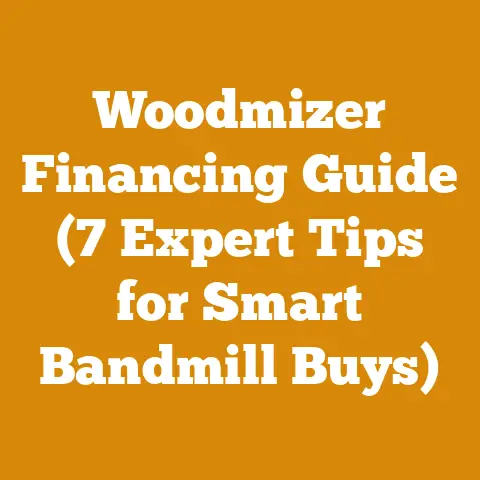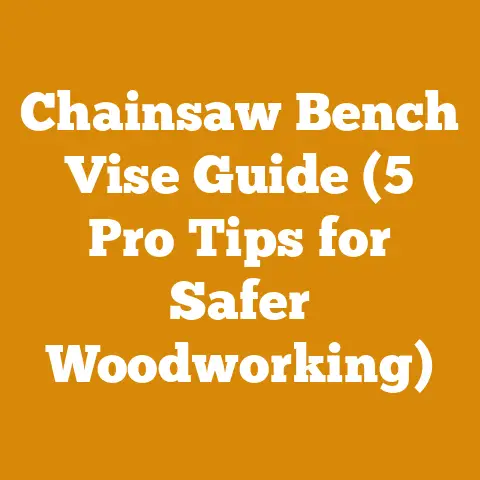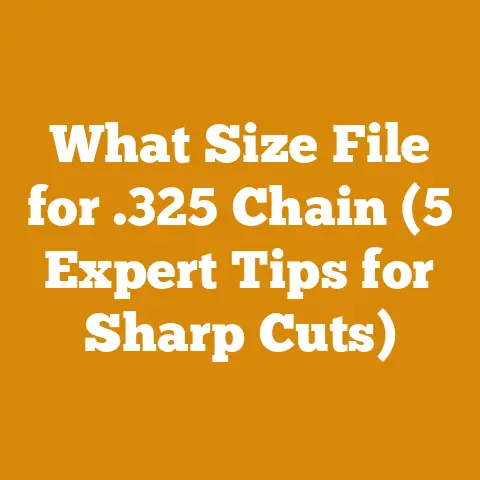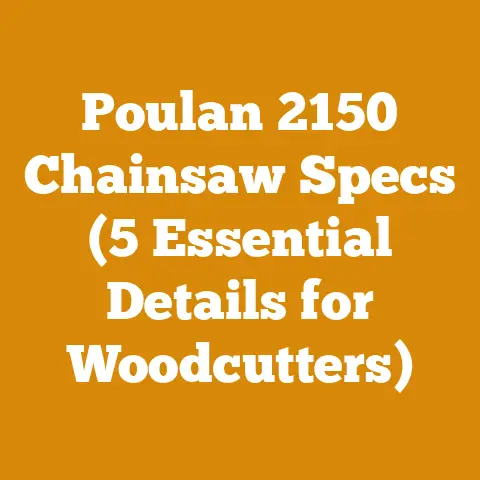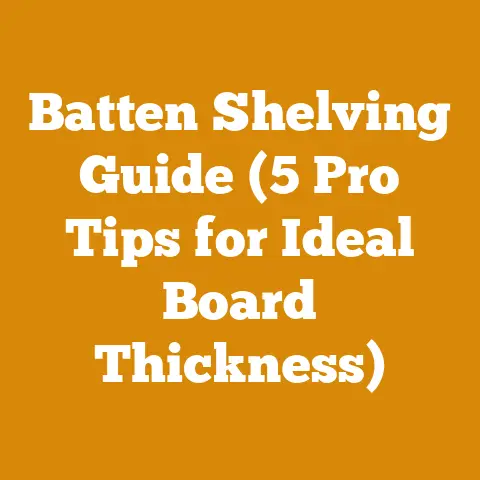Stump Grinder Weights Explained (Trailer Towing & Safety Tips)
I hitched a small stump grinder to my truck, thinking, “She’ll be right, mate,” only to discover on a steep downhill that “she” had a whole lot more say in where we were going than I did. The tail was wagging the dog, as they say. That near-miss taught me a valuable lesson about understanding the weight and towing capacity of these machines.
Stump Grinder Weights Explained (Trailer Towing & Safety Tips)
This guide is designed to help you understand the weights associated with stump grinders, how to safely tow them, and essential safety tips to prevent accidents. Whether you’re a seasoned professional or a weekend warrior tackling a few stumps, knowing this information is crucial for your safety and the longevity of your equipment.
Understanding Stump Grinder Weights
The weight of a stump grinder is more than just a number; it’s a critical factor that influences everything from towing capacity to operational stability. Let’s break down the different types of weights you need to be aware of.
Types of Stump Grinder Weights
- Dry Weight: This is the weight of the stump grinder without any fluids (fuel, oil, coolant). It’s the bare-bones weight and often the number manufacturers advertise.
- Operating Weight: This is the weight of the stump grinder with all fluids at their recommended levels. This is the weight you should use when calculating towing capacity.
- Gross Vehicle Weight (GVW): This is the maximum permissible weight of the stump grinder and its trailer, including the grinder itself, any cargo, and all fluids.
- Tongue Weight: This is the amount of weight that the trailer tongue exerts on the hitch of your towing vehicle. It’s crucial for stability.
Weight Ranges of Different Stump Grinder Types
Stump grinders come in various sizes and configurations, each with its own weight range. Here’s a general overview:
- Hand-Guided Stump Grinders: These are the smallest and lightest, typically weighing between 100 and 300 pounds. They are designed for small jobs and easy maneuverability.
- Towable Stump Grinders: These are larger and more powerful, ranging from 500 to 2,000 pounds. They require a trailer for transport and are suitable for medium to large-sized stumps.
- Self-Propelled Stump Grinders: These machines can weigh anywhere from 1,500 to 4,000 pounds or more. They are designed for professional use and can handle very large stumps.
- Hydraulic Stump Grinders (Skid Steer Attachments): These vary significantly based on the skid steer’s size, but the grinder attachment alone can add between 500 and 1,500 pounds.
Data Points: Stump Grinder Weight Examples
| Stump Grinder Type | Example Model | Dry Weight (lbs) | Operating Weight (lbs) | GVW (lbs) |
|---|---|---|---|---|
| Hand-Guided | NorthStar 13 HP Stump Grinder | 220 | 235 | N/A |
| Towable | DK2 Power 14 HP Stump Grinder | 550 | 575 | 750 |
| Self-Propelled | Rayco RG25 | 1,700 | 1,850 | N/A |
| Hydraulic (Skid Steer) | Blue Diamond Skid Steer Grinder | 850 | 875 | N/A |
Note: Weights are approximate and may vary based on specific models and configurations.
Why Weight Matters
Understanding these weights is crucial for several reasons:
- Towing Safety: Exceeding your vehicle’s towing capacity can lead to accidents, damage to your vehicle, and legal issues.
- Equipment Longevity: Overloading a stump grinder can cause premature wear and tear on its components, reducing its lifespan.
- Operational Stability: A properly balanced stump grinder is safer and more efficient to operate.
- Legal Compliance: Many jurisdictions have regulations regarding towing weights and trailer requirements.
Towing Stump Grinders Safely
Towing a stump grinder requires careful planning and execution. Here are the key steps to ensure a safe and successful tow.
Step 1: Know Your Towing Vehicle’s Capacity
Your vehicle’s towing capacity is the maximum weight it can safely tow. This information can be found in your vehicle’s owner’s manual or on a sticker located on the driver’s side doorjamb. Never exceed this limit!
Data Points: Towing Capacity Considerations
- Gross Vehicle Weight Rating (GVWR): The maximum permissible weight of your vehicle, including passengers, cargo, and fluids.
- Gross Combined Weight Rating (GCWR): The maximum permissible weight of your vehicle and the trailer combined.
- Payload Capacity: The maximum weight your vehicle can carry, including passengers, cargo, and the tongue weight of the trailer.
Example: A pickup truck with a GVWR of 7,000 lbs and a GCWR of 12,000 lbs. If the truck weighs 5,000 lbs, the maximum trailer weight it can tow is 7,000 lbs (12,000 – 5,000).
Step 2: Choose the Right Trailer
The trailer you use to tow your stump grinder must be properly rated for the weight of the machine. Consider the following:
- Trailer Weight Capacity: Ensure the trailer’s GVWR is greater than the operating weight of the stump grinder.
- Trailer Size: The trailer should be large enough to comfortably accommodate the stump grinder without overhang.
- Trailer Brakes: Trailers with a GVWR over a certain weight (often 3,000 lbs) are required to have brakes in many jurisdictions. Check your local regulations.
Data Points: Trailer Specifications
| Feature | Specification | Importance |
|---|---|---|
| Axle Rating | Match or exceed half the trailer’s GVWR | Prevents axle failure due to overloading. Crucial for safety and longevity. |
| Tire Rating | Load range equivalent to axle rating | Ensures tires can handle the weight. Check sidewall for max load. |
| Brake Type | Electric or hydraulic, based on trailer weight | Electric brakes are common for lighter trailers, while hydraulic surge brakes are often used for heavier loads. State laws often dictate requirements. |
| Decking Material | Wood or steel | Wood provides a good grip and is easy to replace, while steel is more durable but can be slippery when wet. Consider anti-slip coatings. |
| Tie-Down Points | Secure and properly rated | Essential for safely securing the stump grinder. Use straps or chains with a working load limit (WLL) that exceeds the weight of the grinder. I once saw a guy use flimsy rope…don’t be that guy. |
| Lighting | Compliant with DOT standards | Includes brake lights, turn signals, and running lights. Ensure they are functional before each trip. Regular checks prevent costly fines and improve safety. |
| Hitch Compatibility | Ball size matches vehicle receiver | Use the correct ball size to ensure a secure connection. A mismatch can lead to the trailer detaching while driving. Always double-check before setting off. I saw a trailer disconnect once because the ball wasn’t properly latched – scary stuff! |
| Suspension | Leaf spring or torsion axle | Leaf spring suspensions are more common and affordable, while torsion axles offer a smoother ride and better weight distribution. Consider the type of terrain you’ll be towing on. |
| Ramps | Adequate length and load capacity | Ramps should be long enough to provide a gentle incline for loading and unloading the stump grinder. Ensure they are rated to handle the weight of the grinder. Avoid makeshift ramps – they are a recipe for disaster. |
| Frame Construction | Welded steel or bolted | Welded frames are generally stronger and more durable than bolted frames. Inspect welds regularly for cracks or signs of stress. Proper frame maintenance ensures the trailer’s structural integrity. |
| Safety Chains | Properly sized and crossed | Safety chains are a crucial backup in case the hitch fails. They should be crossed under the tongue and attached to the vehicle’s frame. Ensure they have sufficient slack to allow for turning. I always make sure mine are in good condition – a broken chain is an accident waiting to happen. |
| Wiring Harness | Properly connected and protected | The wiring harness connects the trailer’s lights to the vehicle’s electrical system. Protect it from damage and ensure all connections are secure. Use dielectric grease to prevent corrosion. Regular maintenance extends the life of the harness and ensures proper lighting function. |
| Brakes | Properly adjusted and functioning | Trailer brakes should be adjusted to provide adequate stopping power without locking up. Regular inspections and maintenance are essential for safe towing. Consider having a professional mechanic inspect the brakes annually. I once had a close call because my trailer brakes weren’t properly adjusted – it’s not something to take lightly. |
| Wheel Bearings | Properly greased and maintained | Wheel bearings should be greased regularly to prevent overheating and failure. Inspect them for signs of wear or damage. Replace them as needed to ensure smooth and safe towing. I learned the hard way about wheel bearing maintenance when one of mine seized up on the highway – a major inconvenience and a potential safety hazard. |
| Tongue Jack | Adequate capacity and easy to use | A tongue jack makes it easier to hitch and unhitch the trailer. Ensure it has sufficient capacity to lift the tongue and is easy to operate. Consider a jack with a wheel for easier maneuvering. A good tongue jack saves time and effort – it’s a worthwhile investment. |
| Fenders | Protect tires and prevent debris spray | Fenders protect the trailer’s tires and prevent debris from being sprayed onto the towing vehicle. Ensure they are securely attached and in good condition. Damaged fenders can be a safety hazard. |
| Mud Flaps | Reduce spray and improve visibility | Mud flaps reduce spray and improve visibility for other drivers. They are especially important in wet or muddy conditions. Ensure they are properly positioned and in good condition. Mud flaps are a simple addition that can significantly improve safety for everyone on the road. |
| License Plate Holder | Securely holds license plate | The license plate holder should securely hold the trailer’s license plate. Ensure it is properly illuminated and visible. A missing or obscured license plate can result in fines. I always double-check my license plate before each trip – it’s a small detail that can save a lot of hassle. |
Step 3: Distribute the Load Properly
Proper load distribution is essential for maintaining stability while towing. Aim for a tongue weight that is 10-15% of the trailer’s total weight. Too little or too much tongue weight can cause the trailer to sway or fishtail.
Data Points: Tongue Weight Calculation
- Ideal Tongue Weight: 10-15% of the total trailer weight.
- Example: If your stump grinder and trailer weigh 1,000 lbs, the ideal tongue weight should be between 100 and 150 lbs.
To adjust tongue weight, move the stump grinder forward or backward on the trailer.
Step 4: Secure the Stump Grinder
Use heavy-duty straps or chains to secure the stump grinder to the trailer. Ensure the straps are properly rated for the weight of the machine and are tightened securely. Cross the straps to prevent the machine from shifting during transit.
Data Points: Strap and Chain Specifications
- Working Load Limit (WLL): The maximum weight a strap or chain can safely handle.
- Breaking Strength: The point at which the strap or chain will fail. Never exceed the WLL.
- Minimum Strap/Chain Rating: The combined WLL of all straps/chains should be greater than the operating weight of the stump grinder.
Example: If your stump grinder weighs 1,000 lbs, use at least two straps with a WLL of 500 lbs each.
Step 5: Inspect Your Setup
Before hitting the road, thoroughly inspect your entire setup:
- Hitch Connection: Ensure the hitch is properly secured and the locking mechanism is engaged.
- Safety Chains: Cross the safety chains under the tongue and attach them to the vehicle’s frame.
- Lights: Check that all lights (brake lights, turn signals, running lights) are working properly.
- Tire Pressure: Ensure the tires on both the towing vehicle and the trailer are properly inflated.
- Brakes: Test the trailer brakes to ensure they are functioning correctly.
Step 6: Driving Tips for Towing
- Drive Slowly: Reduce your speed and allow for extra braking distance.
- Avoid Sudden Movements: Avoid sudden acceleration, braking, or steering.
- Use Mirrors: Use your mirrors to monitor the trailer and surrounding traffic.
- Check Your Load: Stop periodically to check that the load is still secure.
- Be Aware of Height: Be mindful of the height of your load when passing under bridges or overpasses.
Data Points: Safe Towing Speeds
- General Recommendation: Reduce your speed by 10-15 mph when towing.
- Legal Limits: Some jurisdictions have specific speed limits for vehicles towing trailers. Check your local regulations.
Safety Tips for Operating a Stump Grinder
Operating a stump grinder can be dangerous if proper safety precautions are not followed. Here are some essential safety tips to keep you safe.
Personal Protective Equipment (PPE)
- Eye Protection: Wear safety glasses or a face shield to protect your eyes from flying debris.
- Hearing Protection: Wear earplugs or earmuffs to protect your hearing from the loud noise of the machine.
- Hand Protection: Wear heavy-duty work gloves to protect your hands from cuts and abrasions.
- Foot Protection: Wear steel-toed boots to protect your feet from falling objects.
- Leg Protection: Wear chainsaw chaps or other protective legwear to protect your legs from flying debris.
Data Points: PPE Standards
- Eye Protection: ANSI Z87.1-rated safety glasses or face shield.
- Hearing Protection: Noise Reduction Rating (NRR) of at least 25 dB.
- Foot Protection: ASTM F2413-rated steel-toed boots.
Pre-Operation Checklist
- Inspect the Machine: Check the machine for any signs of damage or wear. Pay close attention to the cutting teeth, belts, and hoses.
- Check Fluid Levels: Ensure all fluid levels (oil, fuel, coolant) are at their recommended levels.
- Clear the Area: Remove any rocks, debris, or other obstacles from the work area.
- Mark Underground Utilities: Contact your local utility companies to mark any underground utilities before you start grinding.
- Inform Others: Let others know that you will be operating the stump grinder and to stay clear of the area.
Safe Operating Procedures
- Start the Machine in a Safe Area: Start the machine in a well-ventilated area away from flammable materials.
- Use Proper Technique: Use a slow, sweeping motion to grind the stump. Avoid forcing the machine or overloading the engine.
- Keep a Firm Grip: Keep a firm grip on the handles and maintain control of the machine at all times.
- Stay Clear of Moving Parts: Keep your hands, feet, and clothing away from moving parts.
- Stop the Machine Before Making Adjustments: Always stop the machine and allow the cutting teeth to come to a complete stop before making any adjustments or repairs.
- Be Aware of Kickback: Be aware of the potential for kickback, which can occur when the cutting teeth bind in the wood.
- Avoid Grinding Near Metal: Avoid grinding near metal objects, such as fences or underground utilities.
- Take Breaks: Take frequent breaks to avoid fatigue.
Data Points: Stump Grinder Safety Statistics
- Common Injuries: Eye injuries, lacerations, fractures, and amputations.
- Causes of Accidents: Lack of training, improper PPE, failure to follow safety procedures, and mechanical failures.
- According to the CDC: Agricultural workers have a higher fatality rate than workers in almost all other industries.
Maintenance Tips
- Sharpen or Replace Cutting Teeth: Keep the cutting teeth sharp to ensure efficient grinding and reduce the risk of kickback.
- Check Belts and Hoses: Inspect belts and hoses for cracks or wear and replace them as needed.
- Lubricate Moving Parts: Lubricate moving parts regularly to prevent wear and tear.
- Change Oil and Filters: Change the oil and filters according to the manufacturer’s recommendations.
- Store the Machine Properly: Store the machine in a dry, secure location when not in use.
Data Points: Maintenance Intervals
| Component | Maintenance Interval |
|---|---|
| Cutting Teeth | As needed |
| Belts | Every 50 hours |
| Oil | Every 100 hours |
| Air Filter | Every 100 hours |
| Fuel Filter | Every 200 hours |
Understanding Wood and Stump Characteristics
To effectively use a stump grinder, it’s beneficial to understand the characteristics of the wood you’re dealing with.
Hardwoods vs. Softwoods
Hardwoods, like oak and maple, are generally denser and more difficult to grind than softwoods, like pine and fir. This affects the speed and efficiency of the grinding process.
Data Points: Wood Density
| Wood Type | Average Density (lbs/ft³) |
|---|---|
| Oak | 45-55 |
| Maple | 35-45 |
| Pine | 25-35 |
| Fir | 20-30 |
Higher density means more resistance to grinding.
Stump Size and Root System
The size and complexity of the stump and its root system will determine the time and effort required to grind it. Larger stumps with extensive root systems may require multiple passes and careful planning.
Wood Moisture Content
The moisture content of the wood can also affect the grinding process. Wet wood is generally easier to grind than dry wood, but it can also be more prone to clogging the machine.
Data Points: Wood Moisture Content
- Green Wood: Moisture content above 30%.
- Air-Dried Wood: Moisture content between 12% and 18%.
- Kiln-Dried Wood: Moisture content below 10%.
Case Study: Grinding a Large Oak Stump
I once had a project where I needed to remove a massive oak stump from a client’s property. The stump was approximately 4 feet in diameter and had an extensive root system. Here’s how I approached it:
- Assessment: I started by assessing the stump and its surroundings. I identified any potential hazards, such as underground utilities and nearby structures.
- Preparation: I cleared the area around the stump and marked the location of any underground utilities.
- Grinding: I used a self-propelled stump grinder to grind the stump. I started by grinding the perimeter of the stump, working my way towards the center. I made multiple passes, gradually lowering the cutting teeth to grind the stump below ground level.
- Root System: I then focused on grinding the root system. I followed the roots as far as possible, grinding them down to a depth of at least 6 inches below ground level.
- Cleanup: Finally, I cleaned up the area, removing any debris and filling the hole with topsoil.
Technical Details: I used a Rayco RG25 stump grinder with a 25-horsepower engine. The grinding process took approximately 8 hours to complete.
Regulations and Compliance
It’s crucial to be aware of any regulations or compliance requirements related to stump grinding in your area.
Local Ordinances
Many municipalities have ordinances regarding noise levels, operating hours, and disposal of stump grindings. Check with your local government to ensure you are in compliance.
Environmental Regulations
Some areas have environmental regulations regarding the disposal of wood waste. Be sure to dispose of stump grindings properly to avoid fines or penalties.
Safety Standards
OSHA (Occupational Safety and Health Administration) has safety standards for operating power equipment, including stump grinders. Familiarize yourself with these standards and follow them carefully.
Data Points: Noise Level Regulations
- OSHA Standard: Permissible Exposure Limit (PEL) for noise is 90 dBA over an 8-hour time-weighted average.
- Local Ordinances: Many municipalities have stricter noise level limits, especially during nighttime hours.
Conclusion
Understanding the weights associated with stump grinders, how to safely tow them, and essential safety tips is crucial for your safety and the longevity of your equipment. By following the guidelines outlined in this guide, you can ensure a safe and successful stump grinding experience. Remember, safety should always be your top priority. Don’t be like me and learn the hard way! Take the time to understand your equipment and follow the proper procedures. Your safety and the safety of those around you depend on it.

